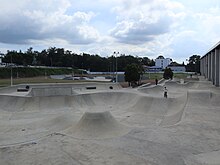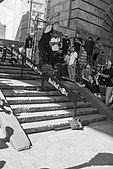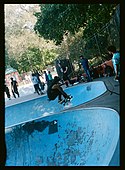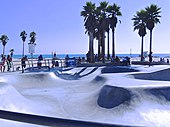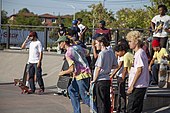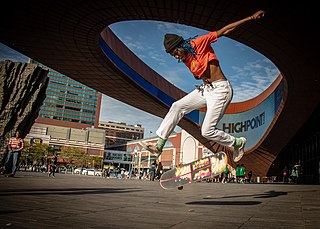
Skateboarding is an action sport that involves riding and performing tricks using a skateboard, as well as a recreational activity, an art form, an entertainment industry job, and a method of transportation. Originating in the United States, skateboarding has been shaped and influenced by many skateboarders throughout the years. A 2009 report found that the skateboarding market is worth an estimated $4.8 billion in annual revenue, with 11.08 million active skateboarders in the world. In 2016, it was announced that skateboarding would be represented at the 2020 Summer Olympics in Tokyo, for both male and female teams.

A half-pipe is a structure used in gravity extreme sports such as snowboarding, skateboarding, skiing, freestyle BMX, skating, and scooter riding.

A funbox is a standard element of a skatepark. It generally consists of a box shape with a flat top and a ramp on two or more sides. A funbox may also include other elements that allow for more complicated skateboarding tricks.

Freestyle BMX is bicycle motocross stunt riding on BMX bikes. It is an extreme sport descended from BMX racing that consists of five disciplines: street, park, vert, trails, and flatland. In June 2017, the International Olympic Committee announced that freestyle park was to be added as an Olympic event to the 2020 Summer Olympics.

FDR Skatepark is a skatepark located in Philadelphia, Pennsylvania, United States. It is accessible from the Pattison Avenue stop of the Broad Street subway line. The park has long been popular with notable local skaters such as Willy Akers, Chuck Treece, Bam Margera, Kerry Getz and various other local pro skaters. The park was built on unused public land in Franklin Delano Roosevelt Park beneath an overpass of Interstate 95. The park came to be through volunteer labor and donations of materials. Over time the park has expanded with additions and inclusions to the area around the original components of the park.
C. Lee Kenagy Park, or just Kenagy Park as it is also known as, is a City Park located in Raytown, Missouri, US. This 18-acre (73,000 m2) multi-purpose park can be found at 79th Street and Raytown Road. It includes many park amenities, and is often visited by Raytown locals. Recent renovations include a larger parking lot, a new playground, a soda machine, and a new entrance.

The Burnside Skatepark is a DIY concrete skatepark located in Portland, Oregon, United States. Burnside was the first DIY skatepark project. It is located under the east end of the Burnside Bridge. The project was started without permission from the city of Portland before being accepted as a public skatepark. Its features include many hips, pools, pyramids, and vertical sections. The skatepark receives no funding from the city of Portland. The park is regarded as an on-going project that is funded by donations.

Harrow Skate Park or Harrow Solid Surf is one of only two remaining 1970's shotcrete skateparks still operating in the United Kingdom. It is located next to Byron Park and Harrow Leisure Centre in Wealdstone in the London Borough of Harrow, England.
Spohn Ranch is a skatepark design and construction firm based in Industry, California. The firm specializes in the construction and design of concrete skateparks and skate plazas, skateable art sculptures, several styles of ramps, and courses for skateboarding, BMX and motocross events.
A skateboard style refers to the way a skateboarder prefers to ride a skateboard. Skateboard styles can be broadly divided into two different categories: skateboarding to perform tricks and skateboarding as a means of transportation. Styles of skateboarding have evolved and are influenced by a number of factors including sociocultural evolution, mass media, music, technology, corporate influence and individual skill level.

Skateboarding arrived in China in April 1986 when an American skateboarder arrived in China to study Chinese at the Beijing Language Institute. He says, "When I arrived in China, there wasn't even a word in Chinese for skateboard. People were really interested in learning to ride, and in a few years Chinese skaters started appearing in almost every city I travelled to". Domestic skate companies and retailers began to appear at around the turn of the century, bringing the average price for a skateboard of ordinary quality down from an expensive 1000 yuan to around 280 yuan as of 2009. Skateboarding has been slow to develop in China because of the lack of a strong preexisting street culture and of skating infrastructure; nevertheless, it's estimated that as of 2009 there are 40,000 to 50,000 skateboarders in China.

Pitcher Park Memorial Skate Park is a skatepark that was built in Carnegie, Pennsylvania. Members of the community of the South Hills of Pittsburgh undertook a grass roots effort to build this as a memorial to honor two brothers, Vincent and Stephen Pitcher, who drowned together on July 15, 2008, while on a camping trip at the Kinzua Dam next to the Allegheny Reservoir.
Turf Skatepark, also known as "Surfin' Turf" or "The Turf", is a former skatepark located in Greenfield, Wisconsin, United States, less than one mile south of the city of Milwaukee. The Turf was an indoor/outdoor facility consisting of five sculptured concrete pools providing some of the best terrain of its time.

Street skateboarding is a skateboarding discipline which focuses on flat-ground tricks, grinds, slides and aerials within urban environments, and public spaces. Street skateboarders meet, skate, and hang out in and around urban areas referred to as "spots," which are commonly streets, plazas or industrial areas. To add variety and complexity to street skateboarding, obstacles such as handrails, stairs, walls, flower beds, bins, park benches, picnic tables, and other street furniture may be traversed as single tricks or as part of a series of consecutive tricks called a "line."

Texas Beach Skate Park, also known as Treasure Island Community Skate Park, is a DIY skatepark located within the planned Riverview Community Park in the Texas Beach riverside area on the north bank of the James River in Richmond, Virginia, United States.

Andy Kessler Skatepark formerly Riverside Skatepark is a skatepark located in Riverside Park on the Upper West Side of Manhattan, New York City. Riverside Skatepark is notable as the first full-sized public skatepark in Manhattan, designed and built by renowned skateboarder and skatepark builder Andy Kessler.

A skate spot is a location used for skateboarding.




